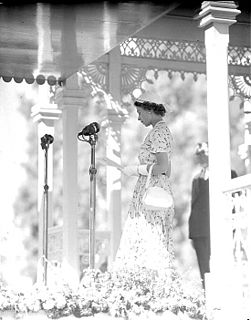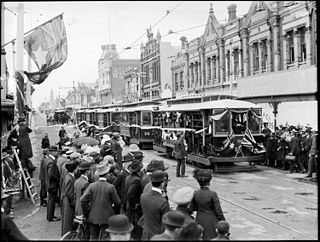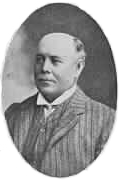Related Research Articles

Gundagai is a town in New South Wales, Australia. Although a small town, Gundagai is a popular topic for writers and has become a representative icon of a typical Australian country town. Located along the Murrumbidgee River and Muniong, Honeysuckle, Kimo, Mooney Mooney, Murrumbidgee and Tumut mountain ranges, Gundagai is 390 kilometres (240 mi) south-west of Sydney. Until 2016, Gundagai was the administrative centre of Gundagai Shire local government area. In the 2016 census the population of Gundagai was 1,925.

Henry Deane was an Australian engineer, responsible for electrifying the Sydney tramway system and for building the Wolgan Valley Railway and Trans-Australian Railway.

Norman John Oswald Makin AO was an Australian politician and diplomat. He was an Australian Labor Party member of the Australian House of Representatives from 1919 to 1946 for Hindmarsh, from 1954 to 1955 for Sturt, and from 1955 to 1963 for Bonython. He was Speaker of the Australian House of Representatives from 1929 to 1932 and served as Minister for the Navy, Minister for Munitions (1941–1946) and Minister for Aircraft Production (1945–1946) under John Curtin, Frank Forde and Ben Chifley. He was the first President of the United Nations Security Council in 1946, and served as Ambassador to the United States from 1946 to 1951.

Since 1867, there have been over fifty visits by a member of the Royal Family to Australia, though only six of those came before 1954. Elizabeth II is the only reigning monarch of Australia to have set foot on Australian soil; she first did so on 3 February 1954. She was only 27 when she first visited Australia. During her sixteen journeys the Queen has visited every Australian state and the two major territories.

The Prahran and Malvern Tramways Trust (PMTT) was a former tram operator in Melbourne, Australia. The trust was formed in 1907, with its first line operating in 1910. Its functions were taken over by the Melbourne & Metropolitan Tramways Board in 1920.

Metters was a brand of stoves and ovens made by Metters & Company, an Australian company established in Adelaide in 1891 by Frederick Metters (1858–1937), who patented and manufactured a number of kitchen appliances notably the 'top-fire' wood stoves. His brothers Charles Henry Metters and John Thomas Metters had earlier founded Metters Bros., making stoves and ovens in Melbourne. Production and distribution of Metters equipment was expanded from Adelaide to Perth, Western Australia, in 1894 where Fred Metters formed a partnership with Henry Spring (1864–1937), and then to Sydney, New South Wales in 1902. Spring bought out his partner in 1907 and founded Metters Limited in 1908 with himself as managing director, and greatly expanded the product range and volume of manufacture in Perth, Adelaide and Sydney.
Frank Beaumont "Beau" Smith, was an Australian film director, producer and exhibitor, best known for making low-budget comedies.
Lawrence Birks was an Australian-born electrical engineer noted for his pioneering work on hydro-electric power generation in New Zealand.
James Martin & Co was an Australian engineering company which progressed from making agricultural equipment to making railway locomotives.

Alexander Cameron was a lawyer, local councillor, and tramways administrator. Following university education he established a legal practice, and later ran for, and won, election on Town of Malvern council. In this position he advocated for the establishment of a local tramway system, and became the inaugural chairman of the Prahran & Malvern Tramways Trust. In 1919 he was appointed as the inaugural chairman of the newly established Melbourne & Metropolitan Tramways Board and presided in that capacity until 1935, creating a unified tram network from the disparate systems that were hitherto operating in Melbourne. He was recognised as a transport expert from his years of experience managing and expanding tramways of Melbourne.

Richard Ernest Nowell Twopeny or Twopenny or Turpenny was an Australian rules footballer, journalist and newspaper editor/owner in New Zealand and Australia.
William Hampden Dutton, generally known as Hampden Dutton, was a pioneering pastoralist in New South Wales and South Australia.
John Acraman was a prominent businessman in the colony of South Australia, and has a place in the history of Australian football in that State.

Sir William George Toop Goodman KBE MICE MIEE MIEAust, until his knighthood invariably referred to as "W.G.T. Goodman", was an engineer and administrator who supervised the installation of New Zealand's first electric tramway and went on to oversee the foundation and growth of the Municipal Tramways Trust in Adelaide, South Australia.
Frederick Metters was an ironworker, founder of the South Australian company which became Metters Limited, of South Australia, Western Australia and New South Wales, known for domestic and industrial cooking ovens and other cooking equipment, and for windpumps. Two of his brothers earlier founded a similarly named company in Victoria known for domestic and industrial cooking ovens.
Nora Burden was a South Australian stained glass artist.
John Graeme Balsillie was an inventor, communications engineer, wireless telegraphy pioneer, business proprietor and senior public servant. He is perhaps best known for oversighting the establishment of Australia's first coastal radio network which utilised a wireless telegraphy system patented by himself and generally known as the Australian system. Born in Brisbane, Queensland, he migrated with his family to London. His studies focused from an early age upon wireless telegraphy and soon found employment in that rapidly developing industry. After a decade of wireless experience, he was recruited by the then Prime Minister Fisher as the "Commonwealth Wireless Telegraphy Expert." He helped to develop the Australian Wireless System free of royalty, jump-starting the nation's radio communications network. The coastal radio network was completed in time to play a significant part in Australia's defence of its borders in World War I.
Sylvester John Browne, occasionally referred to as Sylvester John Browne jnr, was a mining magnate, adventurer and sportsman, whose activities spanned practically the whole of Australia. He was a brother of the well-known author Thomas Alexander Browne.
Leslie Bradford was a mining engineer in Australia credited with several important inventions in the treatment of metal-bearing ores.
Clement Sabine was a manager of several large pastoral properties in the early days of South Australia.
References
- ↑ "History of Noyes Bros". Noyes Bros. Retrieved 12 March 2016.
- ↑ "Mr. Edward Noyes". The Sydney Morning Herald (25, 638). 8 March 1920. p. 6. Retrieved 12 March 2016– via National Library of Australia.
- ↑ "Patents and Inventions". The Sydney Mail and New South Wales Advertiser . LVII (1768). 26 May 1894. p. 1085. Retrieved 12 March 2016– via National Library of Australia.
- ↑ "Patents and Inventions". Evening News (8814). New South Wales. 3 September 1895. p. 7. Retrieved 12 March 2016– via National Library of Australia.
- ↑ "Patents and Inventions". Australian Town and Country Journal . LIX (1535). New South Wales. 8 July 1899. p. 62. Retrieved 12 March 2016– via National Library of Australia.
- ↑ "Patents and Inventions". Australian Town and Country Journal . LX (1579). New South Wales. 12 May 1900. p. 59. Retrieved 12 March 2016– via National Library of Australia.
- ↑ "Advertising". South Australian Register . LXV (16, 810). 28 September 1900. p. 2. Retrieved 12 March 2016– via National Library of Australia.
- ↑ Probably a contraction of Obediah, a name seen in full in earlier members of his family.
- ↑ During this time he was known as "Harry" Noyes.
- ↑ "Obituary". The Observer . LXXIX (5, 904). Adelaide. 25 March 1922. p. 31. Retrieved 12 March 2016– via National Library of Australia.
- ↑ Unknown (1900), "Holmby" Malvern Road , retrieved 13 March 2016
- ↑ "A Popular Electrician". Evening News (11, 127). New South Wales. 9 February 1903. p. 3. Retrieved 12 March 2016– via National Library of Australia.
- ↑ "About People". The Age (24, 014). Victoria, Australia. 30 March 1932. p. 7. Retrieved 12 March 2016– via National Library of Australia.
- ↑ "Mr. J. H. D. Brearley". The Age (26988). Victoria, Australia. 16 October 1941. p. 8. Retrieved 12 March 2016– via National Library of Australia.
- ↑ "The School of Mines". The Advertiser . XLVI (14, 153). Adelaide. 27 February 1904. p. 7. Retrieved 13 March 2016– via National Library of Australia.